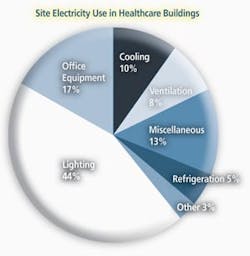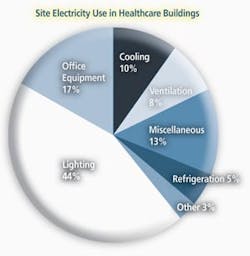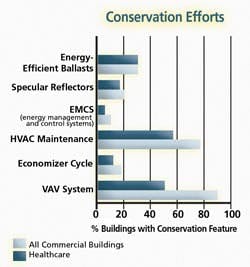Start Saving Energy - Operation: Energy Management
It's a 24/7 operation - literally. With surgical procedures, examinations, and medical testing being done every day, buildings devoted to healthcare are constantly in use.
According to the U.S. Environmental Protection Agency's voluntary program, EnergyStar, all-electric healthcare facilities around the country have an energy intensity* nearly twice that of the average building. If statistics are any indication, energy management in this type of setting is unlike energy management in any other application.
Taking into account the needs of patients is top priority. "We can't just minimize the use of energy or ask folks to put on a sweater. Our environment needs to be warm, comfortable, and friendly in the same manner as someone's home. Our primary goal in this business is to provide excellent patient care," explains Merrie Winston, assistant vice president of facilities, Virtua Health, Marlton, NJ.
Jerry Gardner, director, facility/technology services at Cascade Health Services in Bend, OR, agrees, explaining that his facilities' main goal is also to increase patient and staff satisfaction.
"Hospitals are very different than any other application," explains Gary Hirsch, vice president, Global Energy Partners, Olympia, WA. "In regards to energy efficiency, people say that their 'core business' comes first. Very few hospitals can afford to put [energy management] ahead of their core business."
Big or small, healthcare facilities share similar thoughts when planning energy management strategies: Patient comfort and care must come first. Healthcare facilities are often faced with issues that other buildings don't need to worry about. Hirsch provides air circulation as an example. Since hospitals don't recirculate air in areas where infection is likely to be an issue, all indoor air goes out and must be filtered, while all outdoor air comes in and must be either heated or cooled. Therefore, hospitals use a great deal of energy just for heating and cooling.
But, there are things healthcare facilities can do to manage their energy consumption without sacrificing patient care. Switching out old lighting systems and lamps for more energy-efficient systems, applying solar film to windows, replacing motors and air-handling units, and implementing building automation systems are techniques that hospitals cite again and again when discussing their approaches to energy management.
"We have 24/7 coverage through that building automation system. We can not only tweak utilities for better management, but we can also look for failure or things that aren't working correctly. If [something] is starting to not work properly, it will show up," notes Gardner. "We're trying to work smarter, not harder."
In some cases, outside professionals can help facilities learn to manage and control their energy costs. "We've contracted with Johnson Controls for a building environmental specialist," says Gardner. "[They tweak] our building automation systems when [they are] here. In the first year we did that, we saved an additional $120,000."
Both Virtua Health and Cascade Health Services have experienced success with their energy management techniques and have paved the way for other healthcare facilities to follow in their footsteps.
According to the U.S. Environmental Protection Agency's voluntary program, EnergyStar, all-electric healthcare facilities around the country have an energy intensity* nearly twice that of the average building. If statistics are any indication, energy management in this type of setting is unlike energy management in any other application.
Taking into account the needs of patients is top priority. "We can't just minimize the use of energy or ask folks to put on a sweater. Our environment needs to be warm, comfortable, and friendly in the same manner as someone's home. Our primary goal in this business is to provide excellent patient care," explains Merrie Winston, assistant vice president of facilities, Virtua Health, Marlton, NJ.
Jerry Gardner, director, facility/technology services at Cascade Health Services in Bend, OR, agrees, explaining that his facilities' main goal is also to increase patient and staff satisfaction.
"Hospitals are very different than any other application," explains Gary Hirsch, vice president, Global Energy Partners, Olympia, WA. "In regards to energy efficiency, people say that their 'core business' comes first. Very few hospitals can afford to put [energy management] ahead of their core business."
Big or small, healthcare facilities share similar thoughts when planning energy management strategies: Patient comfort and care must come first. Healthcare facilities are often faced with issues that other buildings don't need to worry about. Hirsch provides air circulation as an example. Since hospitals don't recirculate air in areas where infection is likely to be an issue, all indoor air goes out and must be filtered, while all outdoor air comes in and must be either heated or cooled. Therefore, hospitals use a great deal of energy just for heating and cooling.
But, there are things healthcare facilities can do to manage their energy consumption without sacrificing patient care. Switching out old lighting systems and lamps for more energy-efficient systems, applying solar film to windows, replacing motors and air-handling units, and implementing building automation systems are techniques that hospitals cite again and again when discussing their approaches to energy management.
"We have 24/7 coverage through that building automation system. We can not only tweak utilities for better management, but we can also look for failure or things that aren't working correctly. If [something] is starting to not work properly, it will show up," notes Gardner. "We're trying to work smarter, not harder."
In some cases, outside professionals can help facilities learn to manage and control their energy costs. "We've contracted with Johnson Controls for a building environmental specialist," says Gardner. "[They tweak] our building automation systems when [they are] here. In the first year we did that, we saved an additional $120,000."
Both Virtua Health and Cascade Health Services have experienced success with their energy management techniques and have paved the way for other healthcare facilities to follow in their footsteps.
SOURCE: COMMERCIAL BUILDINGS ENERGY CONSUMPTION SURVEY (CBECS), 1995Bend, OR-based St. Charles Medical Center, part of Cascade Health Services, was the first hospital in the nation recognized by EnergyStar for its energy saving upgrades. A voluntary program that promotes energy performance as a way for healthcare facilities to improve financial performance while protecting the environment, EnergyStar now offers a benchmarking system to let hospitals know where they fall in terms of their energy management strategies.
"We knew that EPA had started its EnergyStar program, and we wanted to be the first hospital. We made it. We were the first hospital in the nation to be recognized. At that time, we were thrown in with everybody else. Now, [the EPA has] made a separate category just for hospitals," notes Gardner. This recognition came after St. Charles had paired with Portland, OR-based Bonneville Power Administration and Milwaukee, WI-based Johnson Controls. They worked together to create a performance contract, allowing St. Charles to pursue its goal of saving $121,000 per year with a payback of seven years.
"We actually paid it off in five years, and that's even with adding additional square footage during that period of time," Gardner explains. "We're pretty proactive [about] cost control, and so we try to get all departments participating and operating at the best they can."
Chuck Haynes, manager, facility services, St. Charles Medical Center, describes his company's energy management strategies as "results-oriented. When we look at our maintenance strategies, we leverage our technologies that will help identify risk (potential equipment failure, energy spikes). We combine this type of proactive risk reduction strategy with [our] other solutions and that really helps the facilities department be a vital part of our mission statement."
Virtua Health, the largest provider of healthcare in southern New Jersey, has pursued energy-efficient upgrades since 1993. An EnergyStar award winner in 2001, Virtua has experienced a 21-percent reduction in annual energy costs due to the implementation of energy management strategies. Teaming with Horsham, PA-based GHR Consulting, Virtua management looked at creative funding opportunities with utility companies and developed a strategy. "We determined an annual energy savings that we could calculate. The strategy was based on combining an institutional conservation program with the demand of site-management programs with electric utility companies," explains Winston. Virtua has also explained strategies to their lease sites, challenging the landlords they rent from to use the same type of energy management and showing them how they can cut expenses while protecting nature.
"We knew that EPA had started its EnergyStar program, and we wanted to be the first hospital. We made it. We were the first hospital in the nation to be recognized. At that time, we were thrown in with everybody else. Now, [the EPA has] made a separate category just for hospitals," notes Gardner. This recognition came after St. Charles had paired with Portland, OR-based Bonneville Power Administration and Milwaukee, WI-based Johnson Controls. They worked together to create a performance contract, allowing St. Charles to pursue its goal of saving $121,000 per year with a payback of seven years.
"We actually paid it off in five years, and that's even with adding additional square footage during that period of time," Gardner explains. "We're pretty proactive [about] cost control, and so we try to get all departments participating and operating at the best they can."
Chuck Haynes, manager, facility services, St. Charles Medical Center, describes his company's energy management strategies as "results-oriented. When we look at our maintenance strategies, we leverage our technologies that will help identify risk (potential equipment failure, energy spikes). We combine this type of proactive risk reduction strategy with [our] other solutions and that really helps the facilities department be a vital part of our mission statement."
Virtua Health, the largest provider of healthcare in southern New Jersey, has pursued energy-efficient upgrades since 1993. An EnergyStar award winner in 2001, Virtua has experienced a 21-percent reduction in annual energy costs due to the implementation of energy management strategies. Teaming with Horsham, PA-based GHR Consulting, Virtua management looked at creative funding opportunities with utility companies and developed a strategy. "We determined an annual energy savings that we could calculate. The strategy was based on combining an institutional conservation program with the demand of site-management programs with electric utility companies," explains Winston. Virtua has also explained strategies to their lease sites, challenging the landlords they rent from to use the same type of energy management and showing them how they can cut expenses while protecting nature.
SOURCE: CBECs, 1995In addition to saving money and the environment, there's another reason energy management is beneficial to healthcare facilities. Dollars saved in energy costs can be redistributed throughout the hospital, providing extra funds for research and for the facility in general. "What we needed to do first of all was convince the top management that we could do it … that we would be able to guarantee there would be savings coming out of this. I think you have to have top management buy in," says Gardner.
Offering advice to those just beginning an evaluation of energy-efficient possibilities, Haynes emphasizes to "take advantage of the resources that are out there. Associations like ASHE (American Society of Healthcare Engineers) are filled with professionals that all have the same opportunities and goals, and there's a way to network with those associations to pick up particular advice from other hospitals."
Offering advice to those just beginning an evaluation of energy-efficient possibilities, Haynes emphasizes to "take advantage of the resources that are out there. Associations like ASHE (American Society of Healthcare Engineers) are filled with professionals that all have the same opportunities and goals, and there's a way to network with those associations to pick up particular advice from other hospitals."


